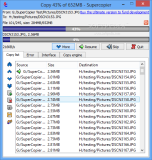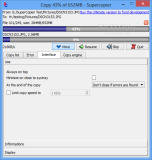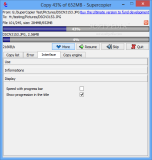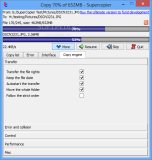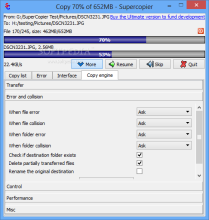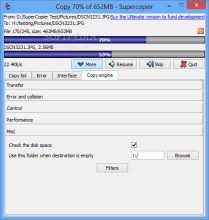Up until the launch of Windows 8, Microsoft did not bother too much with the improvement of the file transfer component in their operating system.
The new OS ushered in a more functional interface that shows speed fluctuations, features the possibility to pause the transfer as well as to manage multiple such tasks in the same screen.
Nevertheless, advanced users require a more flexible panel for file transfers, one that permits control over the job.
Once again, it fell to third-party developers to come up with tools that accommodate such needs and one of the utilities that may fit the bill is SuperCopier.
The application is absolutely free of charge and behaves in the exact same manner as Ultracopier because both tools are currently under the same development and share more than the engine because even the interface is identical; both of them are available as a portable download.
As soon as launched, SuperCopier takes the intermediation of the file transfer jobs upon itself. As such, dragging and dropping files in Windows Explorer will prompt the SuperCopier application window and allow access to all its features and options.
There is no interface per se for this utility, only a configuration panel that can be accessed from the context menu of the system tray icon. It includes general options touching on the behavior of the program when a transfer job is initiated as well as settings for customizing the tasks.
You can enable grouping of the windows under certain conditions such as source and/or destination being the same.
However, the most significant customizations refer to the actual file transfer, be it a copy or a move job.
The application’s behavior in case of errors and collisions can be easily defined from the Ultracopier submenu of the configuration panel. The options at hand include prompting the user, skipping or placing said file at the end of the queue.
The choices for tweaking the transfer performance are what advanced users seek and these cover setting up the default block size, selecting an algorithm (sequential or parallel) more suitable for the type of transfer running along with defining larger buffers.
All the activity carried out by SuperCopier can be logged to user-defined areas. This file can also be customized in terms of the information it stores. Based on variables provided in the program, the report can hold details about time, source, destination, size, path or user initiating the transfer and the errors that occurred during the job.
SuperCopier seems to be designed to offer a more flexible way to move or copy files from one location to another than to speed up the actual transfer.
During our tests, we compared the transfer speed of the default solution in Windows 8 with what SuperCopier can achieve. When transferring multiple small files, the difference was clearly in favor of Microsoft’s solution, but the third-party tool showed that it can do better with large chunks of data.
Windows Explorer scored better when copying a 2.24GB folder holding 13,000 files as the fastest time it recorded was 1’50’’, while SuperCopier’s best was 2’14’’. The worst times were 2’11’ and 2’38’’ respectively. Calculating the average did not tip the balance to SuperCopier’s favor.
Moving these files from one partition to another showed the same results, although the score was tighter as the difference was much smaller with SuperCopier’s best being 2’21’’ and Windows Explorer’s being 2’16’’. The worst times recorded still put Microsoft solution ahead with 2’31’’ compared to the third-party tool’s 2’43’’.
On the other hand, our tests showed that SuperCopier is better than Windows Explorer at copying and moving large files between partitions. The fastest the Ultracopier-powered application copied a 11.2GB file was 4’58’’ while the default solution in Microsoft’s OS completed the job in 5’24’’. The worst times for this test were 5’06’’ for SuperCopier and 5’34’’.
Moving the file did not result in a change and the built-in tool scored 5’14’’ at its best and 5’35’’ at its worst. Alternatively, SuperCopier completed the job in 5’02’’ and 5’06’’ respectively.
Although SuperCopier recorded low scores for copying and moving, it brings to the table other advantages. It allows prioritizing the transfer of files by moving them to a different position in the list.
Furthermore, you can add more files to the transfer list as well as save it for initiating the operation at a later time. The built-in search function helps you easily find a specific item in order to change its position or remove it altogether from the batch.
The Good
You have control over the behavior of the application in case of errors or file collision. You can control the transfer priority for specific files and use the search function to find them in the transfer list.
 14 DAY TRIAL //
14 DAY TRIAL // 